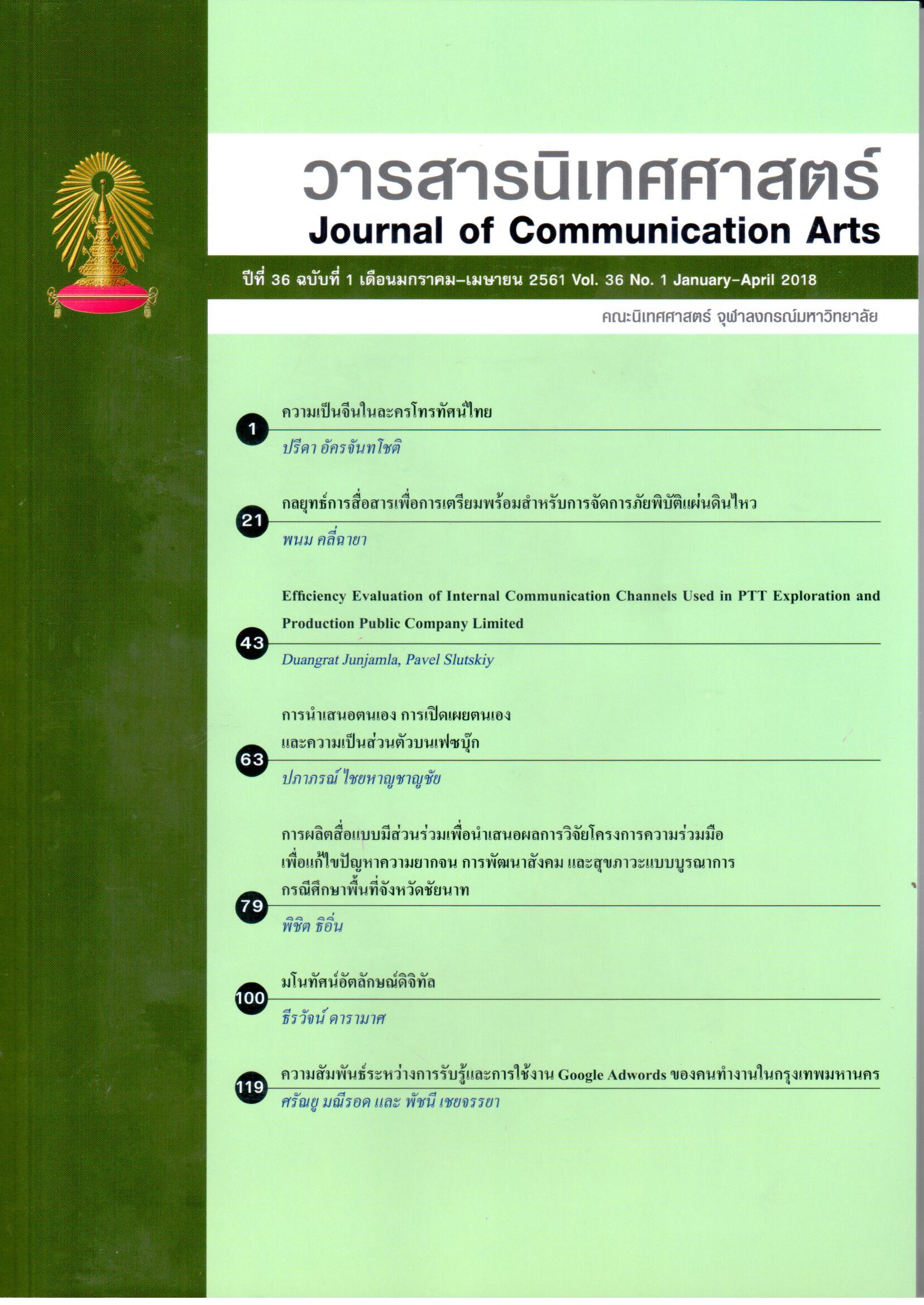ความสัมพันธ์ระหว่างการรับรู้และการใช้งาน Google AdWords ของคนทำงานในกรุงเทพมหานคร
Main Article Content
Abstract
This research aim to study about relationship between perception and usage, and guidelines on using Google AdWords trend from working people in Bangkok. By a group of samples used in this research were people who work in Bangkok. Use a Mixed research methodology using research tool as in-debt interviews from 10 people in Digital Media society. And use survey research by Online Questionnaire 200 people. The research result found that 1) The Google AdWords focus on the main purpose of each tools. By the tools have different usage types of applications. 2) Most interviewers were those working in individual company between the ages 22-35 years old that interested in getting to know and using Google AdWords. 3) The hypothesis research found that different age ranges have different perceptions about Google AdWords and perceived benefits associated with using Google AdWords.
Article Details
References
จตุพล ทานาฤทัย. (2549). Search engine marketing 2.0. กรุงเทพฯ: โกเบลท.
จุมพล ตรีเพชรสมคุณ. (2560). ความรับผิดชอบของเสิร์ชเอ็นจิ้น (Search Engine) กับกรณีการฉ้อโกงอันเกิดจาก การทำการตลาดโดยการลงโฆษณาบนเว็บเสิร์ชเอ็นจิ้น / (Click Fraud) Liability of Search Engine: Click Fraud on Search Engine Marketing Case Study. มหาวิทยาลัยกรุงเทพ. สืบค้นจาก http://dspace.bu.ac.th/bitstream/123456789/901/1/jumpol_tree.pdf
จอห์นนพดล วศินสุนทร. (2553). ยูทูบ วิดีโอ ออนไลน์ สื่อทำลายหรือสร้างสรรค์สื่อ. สืบค้นจากสังคม://johnnopadon.blogspot.com/2010/04/youtube.html
ฉัฐมณฑน์ ตั้งกิจถาวร. (2557). การใช้ประโยชน์และความพึงพอใจในการเปิดรับข้อมูล ที่ถูกแชร์ (Shared) ผ่านเฟสบุ๊ค. มหาวิทยาลัยกรุงเทพ. สืบค้นจาก http://dspace.bu.ac.th/bitstream/123456789/1635/1/
chattamon_tang.pdf
ชุติสันต์ เกิดวิบูลย์เวช. (2559). สื่อดิจิทัลใหม่ สื่อแห่งอนาคต. กรุงเทพฯ: สถาบันบัณฑิตพัฒนบริหารศาสตร์.
โชติรัตน์ ศรีสุข. (2554). กลยุทธ์การสื่อสาร และการรับรู้รูปแบบ โครงการความรับผิดชอบต่อสังคมต่อสังคม ของบริษัท ไทยเบฟเวอเรส จำกัด (มหาชน). มหาวิทยาลัยศิลปากร. สืบค้นจากhttp://www.thapra.lib.su.ac.th/objects/thesis/fulltext/snamcn/Chotirat_Srisuk/fulltext.pdf
ณัฐพล ใยไพโรจน์. (2557). Digital marketing concept & case study. นนทบุรี: ไอดีซี พรีเมียร์.
ปรมะ สตะเวทิน. การสื่อสารมวลชน กระบวนการและทฤษฎี (พิมพค์รั้งที่ 2). กรุงเทพฯ: ภาพพิมพ์, 2541.
พัชนี เชยจรรยา. (2558). ความสัมพันธ์ของแต่ละรูปแบบการใช้ชีวิตกับความถี่ในการใช้เครือข่ายสังคมออนไลน์และการรับรู้ประโยชน์จากสื่อสังคม. วารสารนิเทศศาสตร์และนวัตกรรม นิด้า, 1
พัชรียา สุตา. (2555). การรับรู้และทัศนคติของผู้บริโภคที่มีต่อการซื้อสินค้าผ่าน QR Code ในเขตกรุงเทพมหานคร. มหาวิทยาลัยเทคโนโลยีราชมงคลธัญบุรี. สืบค้นจาก http://www.repository.rmutt.ac.th/bitstream/
handle/123456789/1485/136398.pdf?sequence=
ภิเษก ชัยนิรันดร์. (2553). การตลาดแนวใหม่ ผ่าน Social Media. กรุงเทพฯ: ซีเอ็ดยูเคชั่น.
วรมน บุญศาสตร. (ม.ป.ป). การสื่อสารการตลาดสู่กลุ่มผู้บริโภคเจเนอร์เรชั่น ซี ในยุคดิจิทัล / “Marketing communications to generation C consumers in the digital age.
สืบค้นจาก http://gscm.nida.ac.th/public-action/eJournal/Vol.1-58/2.pdf
วิลาสินี สงวนวงษ์. (2557). การรับรู้ข่าวสารการตลาดและการตัดสินใจซื้อเครื่องสำอางของคนรุ่นใหม่เพศหญิงผ่านกูรูความงาม.
สืบค้นจาก http://repository.nida.ac.th/handle/662723737/3317
อริศรา ปาดแม้น. (2543). ปัจจัยที่มีอิทธิพลต่อการรับรู้ระบบความปลอดภัยและพฤติกรรมความปลอดภัยของพนักงานในโรงงานอุตสาหกรรม. มหาวิทยาลัยเกษตรศาสตร์.
อัศวิน เนตรโพธิ์แก้ว. (2557). นวัตกรรมสื่อสังคมกับประชาคมอคติ. วารสารนิเทศศาสตร์และนวัตกรรม นิด้า สถาบันบัณฑิตพัฒนบริหารศาสตร์, 1(1), 19–32.
Dalton, N. S., Collins, E., & Marshall, P. (2015). Display blindness?:Looking again at the visibility of situated displays using eye-tracking. In Proceedings of the 33rd Annual ACM Conference on Human Factors in Computing Systems (pp. 3889-3898). ACM.
Esther W. (2015). Adwords Optimization. Online information review. Retrieved from https://beta.vu.nl/nl/Images/werkstuk-weusthof_tcm235-426267.pdf
Getoar Vejseli, Hanifi Rexhaj. (2014). Pay per Click marketing strategy: How to develop a successful online marketing strategy with Google AdWords and Facebook. Retrieved from https://diuf.unifr.ch/main/is/sites/diuf.unifr.ch.main.is/files/documents/student-projects/Group_6_Vejseli_Rexhaj.pdf
Griffiths, M. D. (1996). Internet addiction: an issue for clinical psychology?.In Clinical psychology forum (Vol. 97, pp. 32-36). London: Nottingham Trent University.
Katz, J. (1997). Virtuous reality: How America surrendered discussion of moral values to opportunists: Nitwits, and Blockhead. New York. Random House.
Katz, E., Blumler, J.G., &Gurevitch, M. (1974). The uses and gratifications approach to mass communication. Beberly Hills, Calif: Sage.
Kawamoto, K. (1997). Digital journalism Emerging Media and the Changing Horizons of journalism. online information review. Retrieved from https://books.google.co.th/books?id=dG9vHw
HyDFUC&pg=PA28&lpg=PA28#v=onepage&q&f=false
Mayfield, A. (2007). What is social media.Retrieved from http://www.icrossing.com/uk/sites/
default/files_uk/insight_pdf_files/What%20is%20Social%20Media_iCrossing_ebook.pdf
Tapscott, D. (1997). Strategy in the new economy. Strategy & Leadership, 25(6), 8-14
Tobin, J. (1998). An American otaku (or, a boy’s virtual life on the net). Digital diversions: Youth culture in the age of multimedia (pp. 106-127). New York: Phycology Press.
Diplomove, P. (2011). Optimizing the return on investment for Google AdWords in B2B Companies Applied to the North American market. Strategie e-business.


